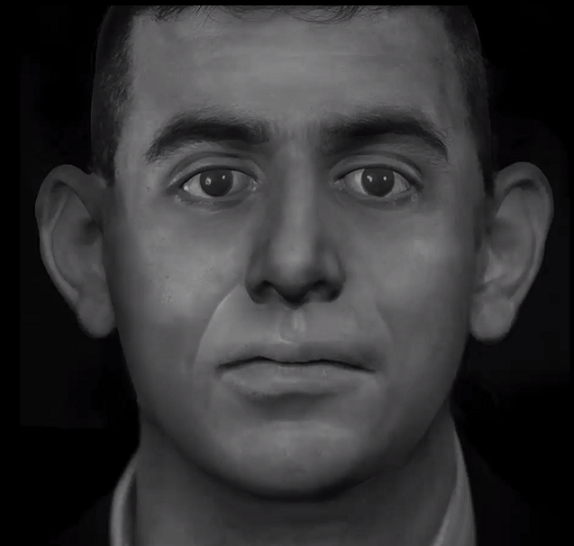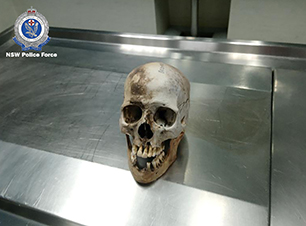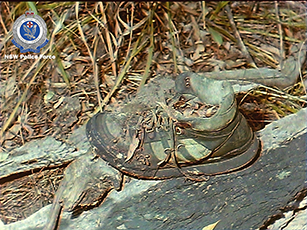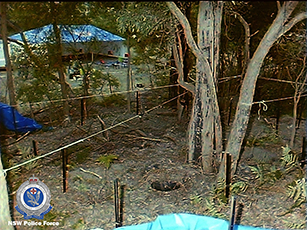
Local detectives have released a digital forensic facial reconstruction as inquiries continue to attempt to identify a man whose remains were located near Campbelltown almost two decades ago.
About 10.30am on Sunday, May 27, 2001, a group of local kids were playing in a reserve on Meredith Crescent, St Helens Park, when one of the boys noticed a skull partially buried in the ground. He took the skull home and showed it to his mum, who contacted police.
Local police and specialist forensic officers conducted a search and excavation of the reserve over a number of days and located almost an entire skeleton.
They also located a gold bracelet, a wrist watch, a cigar tin, a lighter, a belt buckle, a belt, men’s clothing and shoes, spent .22 calibre casings, as well as food tins and glass bottles.
The bones were subject to anthropological analysis and various forensic examinations, and despite exhaustive inquiries and comparisons to missing persons cases from across the state, detectives were not able to identify the man at the time.

A 2004 coronial inquiry found that while the man could not be identified, and the date, place, manner and cause of his death were undetermined, it’s believed he was aged between 35 and 45, and was likely buried between 1989 and 1993.
In the following years, detectives continued to conduct inquiries but weren’t able to confirm the man’s identity.
Following a 2017 review of unsolved cases and new technologies available, detectives from Campbelltown City Police Area Command renewed Strike Force Tavoy to investigate the matter.

As part of their inquiries, investigators sent bone samples to the University of Waikato’s Radiocarbon Dating Laboratory in New Zealand, which determined the man died between 1980 and 1985.
Police have been working closely with forensic experts to conduct a range of DNA tests, including phenotyping, which involves using genetic sequencing to predict a person’s physical characteristics.
Results of these advanced DNA tests suggest the man most likely had dark brown/black hair, brown eyes, and a mixed ancestry of South Asian and Middle Eastern, however, experts advised ancestry may not be reflected in physical appearance.
Late last year, investigators engaged the Centre for Anatomy and Human Identification at the University of Dundee in Scotland to construct a digital forensic facial reconstruction.
Investigators have released the artist’s impressions developed through the reconstruction, which depict what the man may have looked like and are appealing for assistance from the community to help identify him.

At the time of the man’s death – which was believed to be in the early 1980s – he was believed to be aged between 35 and 45, and described as 166-174cm tall, with a muscular build, dark brown/black hair, and brown eyes.
Campbelltown City Crime Manager, Detective Chief Inspector Greg Inger, appealed to the community to look at the images to see if they recognise the man from their past.
“The artist impressions give us a scientific estimation of what the man may have looked like and we believe this is our best chance to identify him and find his loved ones,” Det Ch Insp Inger said.
“We have made significant inquiries already, and while we’ve yet to find a match in our missing persons database, we know someone, somewhere, is waiting for answers.
“It’s also likely he may remind someone of a man they knew way back when – and if they’d lost contact in the early 1980s – that’s important information to us.”
Det Ch Insp Inger added that Strike Force Tavoy is a multi-layered investigation and determining the man’s identity would likely provide additional lines of inquiry into the circumstances surrounding his death.
“The remains were examined by a forensic pathologist, anthropologist, and archaeologist, who were unable to find any markings or injuries which could suggest or indicate a potential cause of death,” Det Ch Insp Inger said.
“Unfortunately, the examination of the area where his remains were found didn’t provide evidence that would definitively conclude whether or not he died in suspicious circumstances.
“Once we know who he is, we can start to establish more about his life, which opens up the investigation into the circumstances surrounding his death,” Det Inger said.
